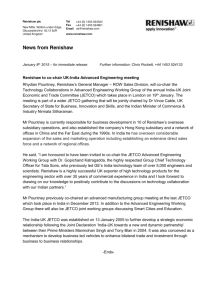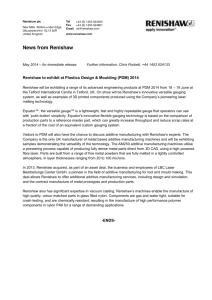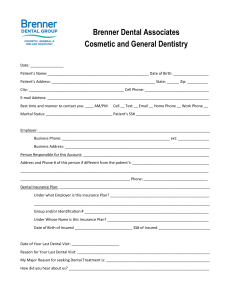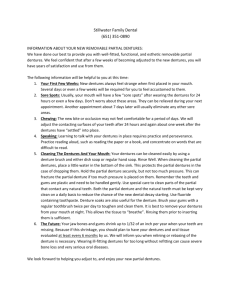The full digitisation of removable partial dentures (RPDs)
advertisement
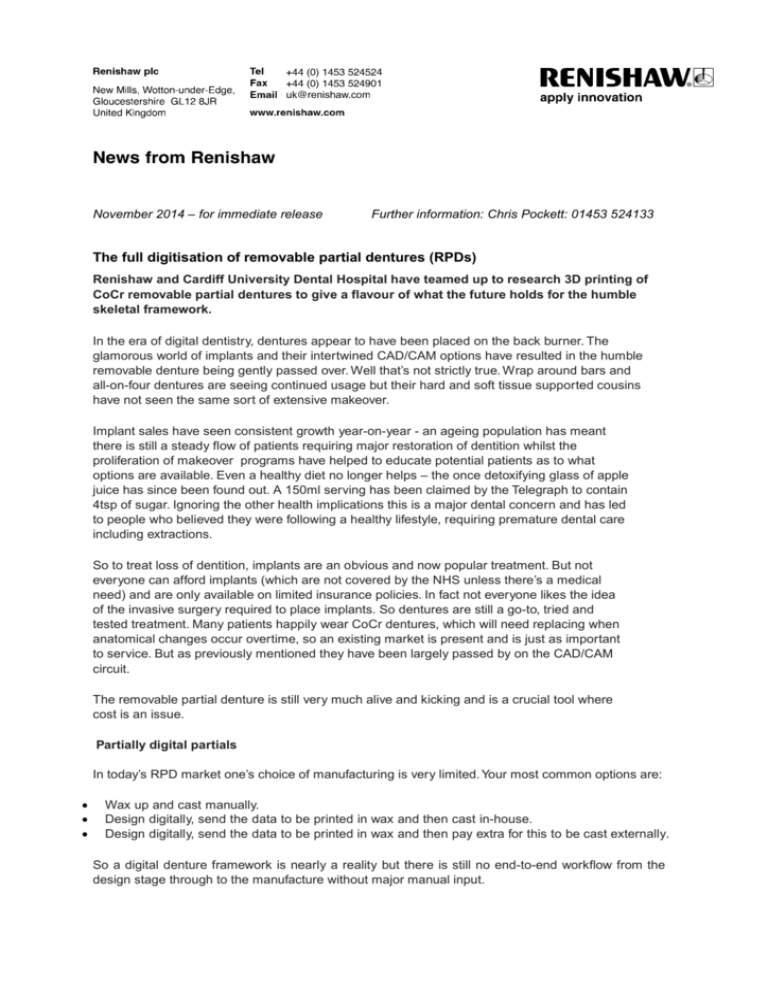
November 2014 – for immediate release Further information: Chris Pockett: 01453 524133 The full digitisation of removable partial dentures (RPDs) Renishaw and Cardiff University Dental Hospital have teamed up to research 3D printing of CoCr removable partial dentures to give a flavour of what the future holds for the humble skeletal framework. In the era of digital dentistry, dentures appear to have been placed on the back burner. The glamorous world of implants and their intertwined CAD/CAM options have resulted in the humble removable denture being gently passed over. Well that’s not strictly true. Wrap around bars and all-on-four dentures are seeing continued usage but their hard and soft tissue supported cousins have not seen the same sort of extensive makeover. Implant sales have seen consistent growth year-on-year - an ageing population has meant there is still a steady flow of patients requiring major restoration of dentition whilst the proliferation of makeover programs have helped to educate potential patients as to what options are available. Even a healthy diet no longer helps – the once detoxifying glass of apple juice has since been found out. A 150ml serving has been claimed by the Telegraph to contain 4tsp of sugar. Ignoring the other health implications this is a major dental concern and has led to people who believed they were following a healthy lifestyle, requiring premature dental care including extractions. So to treat loss of dentition, implants are an obvious and now popular treatment. But not everyone can afford implants (which are not covered by the NHS unless there’s a medical need) and are only available on limited insurance policies. In fact not everyone likes the idea of the invasive surgery required to place implants. So dentures are still a go-to, tried and tested treatment. Many patients happily wear CoCr dentures, which will need replacing when anatomical changes occur overtime, so an existing market is present and is just as important to service. But as previously mentioned they have been largely passed by on the CAD/CAM circuit. The removable partial denture is still very much alive and kicking and is a crucial tool where cost is an issue. Partially digital partials In today’s RPD market one’s choice of manufacturing is very limited. Your most common options are: Wax up and cast manually. Design digitally, send the data to be printed in wax and then cast in-house. Design digitally, send the data to be printed in wax and then pay extra for this to be cast externally. So a digital denture framework is nearly a reality but there is still no end-to-end workflow from the design stage through to the manufacture without major manual input. Currently Cardiff University Dental Hospital (CUDH) manufacture380 to 400 chromes per year and although remakes are generally kept to a minimum they still see miscasts, the number of which they are constantly aiming to reduce. There are numerous variables that can result in a miscast as a result of the protracted workflow and complex nature of an RPD. In addition to miscasts a number of other factors can affect the need for a remake including design changes, longevity between appointments and/or impression inaccuracies which may be attributed to the inexperience of dental undergraduates in the teaching environment. Industry feedback suggests there could be between 14 to 20% of castings requiring remakes, figures which would be unthinkable in most other manufacturing industries. With increasing environmental and economic pressures it’s critical that this situation is brought under control so that lab efficiency can be further enhanced and quality dental care be made available to a larger proportion of the populace. Academic, commercial and clinical entities working in harmony In order to address the aforementioned issues and bring RPDs fully into the digital age a number of questions require a structured approach. Renishaw’s David Cruickshank has been working on this very subject for his PhD into digital denture design. A past student of Cardiff Metropolitan University (previously University of Wales Institute, Cardiff), David graduated in dental technology. He’s always had a soft spot for dentures and working with metal 3D printing on a daily basis at Renishaw, means this couldn’t be a better fit for his PhD thesis. David has been working with this new manufacturing process in conjunction with Roger Maggs RDT, Senior Chief Dental Laboratory Manager, Mr Liam Addy, Consultant in Restorative Dentistry and Paul Clark RDT, Senior Dental Technologist, all based at CUDH. The specific areas of research include how to design dentures in the digital environment, what material grades give the best performance and how to manufacture dentures using additive manufacturing (AM) in an effective manner. Benefits of digital vs traditional dentures seen by CUDH Reduced maintenance costs for expensive furnaces and casting equipment. Less wasted alloy. No wasted wax. No wasted investment material. Improved health and safety features. Potential reduction in environmental impact due to waste reduction. Ability to recall, change design and remanufacture without the need to restart the entire process. Share designs between technicians and clinicians via internet/e-mail to help productivity. Shorter process workflow. The design The number of design packages is now growing, however, the options are still limited compared to crown and bridge and implantology. In this study, to give maximum flexibility the team used Freeform™ software coupled with the Sensable® Haptic Device, now owned by Geomagic® and sold under the name Touch™ X. This coupled with a Renishaw DS20 optical scanner gave the full suite of design tools required. Once the master model was scanned it was imported directly into the Freeform software. From here the operator can start to identify the insertion axis and block out undercuts. The undercuts can be varied to allow for tighter or looser retention. Also at this time, clearance from the gingiva can be dialled in to accommodate acrylic thickness. Following this the design process can really start in earnest. A full suite of indirect and direct retainers, major connectors and acrylic retention features can be designed into the denture. Using the Haptic arm can be a little alien at first but soon becomes second nature and the user will be quickly designing occlusal rests with intricate reciprocal and retentive arms. Acrylic retention can also be designed-in using a variety of mesh options and surface modifications, just as for a traditional RPD. Manufacture At this point in the process, many digital RPDs would be printed in wax and then invested and cast. However CUDH and Renishaw were able to bypass this and manufacture direct in a dental grade, CE marked CoCr using Renishaw’s AM250 additive manufacturing (AM) machines. In AM’s most simplistic form a thin layer of metal powder, 20 microns thick, is consolidated with a super fine laser beam and the dental framework is built up layer-by-layer. It is extremely good at producing highly detailed complex surfaces. Virtually all the features that are in the design can be replicated without any loss of detail. The major benefit for CUDH is that they simply send the .stl data to Renishaw for manufacture and can work on the next job instead of having to work through the highly skilled investment casting process. This can help make the lab process more efficient and cost effective. Assessment At this stage of research the team at CUDH concentrated on fit and comfort to the patient with the assessment being carried out by Dr Liam Addy. The assessment was carried out over 10 cases. Each case had both a traditional and a digital RPD framework manufactured with matching design characteristics. The frameworks were then completed, ready for assessment by Dr Addy. Dr Addy carried out patient try-ins of both variants in each case. Using his extensive experience and the patients’ feedback on comfort and retention he was able to gauge which was the best method. So far the score is 10 cases out of 10 in favour of digital RPDs in CUDH’s opinion. For more information about Renishaw’s full range of dental products, please visit www.renishaw.com/dental -EndsAbout Renishaw Renishaw is an established world leader in engineering technologies, with a strong history of innovation in product development and manufacturing. Since its formation in 1973, the company has supplied leading-edge products that increase process productivity, improve product quality and deliver cost-effective automation solutions. A worldwide network of subsidiary companies and distributors provides exceptional service and support for its customers. Products include: Additive manufacturing and vacuum casting technologies for design, prototyping, and production applications Dental CAD/CAM scanning systems and supply of dental structures Encoder systems for high accuracy linear, angle and rotary position feedback Fixturing for CMMs (co-ordinate measuring machines) and gauging systems Gauging systems for comparative measurement of machined parts High speed laser measurement and surveying systems for use in extreme environments Laser and ballbar systems for performance measurement and calibration of machines Medical devices for neurosurgical applications Probe systems and software for job set-up, tool setting and inspection on CNC machine tools Raman spectroscopy systems for non-destructive material analysis Sensor systems and software for measurement on CMMs Styli for CMM and machine tool probe applications For worldwide contact details, visit www.renishaw.com/contact
